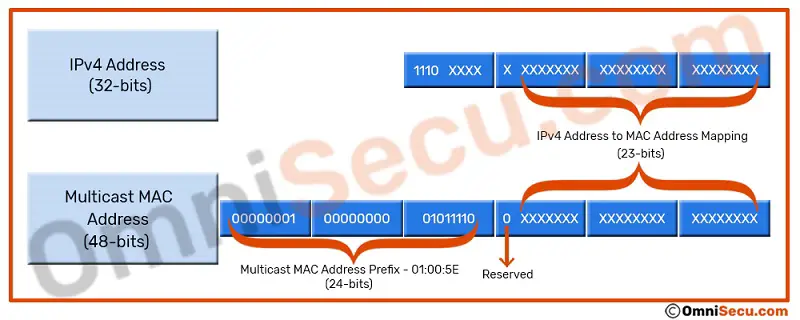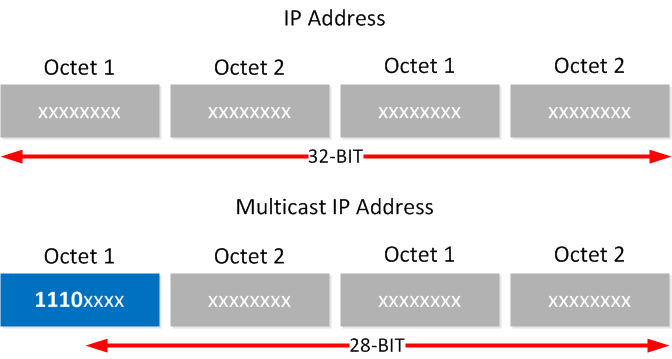

High-bandwidth software download is being transmitted on multicast IP address 224.1.2.3 and IP-aware and will do their multicast filtering based on MAC addresses. Similar) will not affect network performance for all users. Users will only "see" multicast traffic they haveĪctually asked for, so that (for example) a high-bandwidth software download (using Ghost or something This has implications for multicast application design. Rather,Įach multicast MAC address will be shared by 32 IP addresses. Not a one-to-one mapping between multicast IP address and multicast MAC addresses. Significant 9 bits of the multicast IP address are quite simply ignored and the remainingĢ3 bits are copied into the lowest 23 bits of the MAC address.Īs a consequence of this, 5 bits of "useful" IP address information being scrapped, there is Non-technical reasons which need not detain us here). Significant three bytes of the MAC address) available into which to encode the IP address.Īctually, it is even worse than this.only the lower 23 bits are available for use (for The astute reader may have noticed a problem by now: There are only 24 bits (the least If we ignore the four most significant bits of the multicast IP address (which,Īs noted earlier, will always be "1110"), that leaves 28 bits of IP address information which Traffic, we would ideally like a one-to-one mapping between multicast IP addresses and multicast Since it is obviously infeasible to have an equivalent of ARP when transmitting multicast If you aren't interested and reading this but just need to do a conversion you can skip ahead to the Address Converter Tool. For IP multicast specifically, the Ethernet prefix

In the Ethernet world, a multicast MAC address is distinguished by a binary '1' in the least
MULTICAST TO MAC ADDRESS CONVERTER FREE
If you are looking for something to test IP multicast on your network you might like to check out our free (but very unfinished !) IP Multicast Tester Ethernet Addressing For the honours students, they are distinguished by the World, they would have been called Class D addresses (although nowadays it is not considered polite If it happens accidentally, a packet from a different IP multicast application can be identified at Layer 3 and discarded however, network administrators should be careful when they implement multicast applications so that they can avoid using IP addresses that produce identical MAC addresses.Multicast IP addresses fall within the range 224.0.0.0 - 239.255.255.255. IETF points out that the chances of two multicast applications on the same LAN producing the same MAC address are very low.

In fact, because 5 bits from the IP address are always mapped to 0, 25 (32) different class D IP addresses produce exactly the same MAC address. Unfortunately, this method does not provide a unique multicast MAC address for each multicast IP address, because only the last 23 bits of the IP address are mapped to the MAC address. Step 6 Combine the first 6 hexadecimal digits 01-00-5E with the last 6 hexadecimal digits, calculated in Step 5, to form a complete multicast MAC address of 12 hexadecimal digits. Step 5 Convert the last 24 bits of the multicast MAC address from binary to 6 hexadecimal digits. Step 4 Copy the last 23 bits of the binary IP address in the last 23-bit space of the multicast MAC address. Step 3 Replace the next 5 bits of the binary IP address with one binary 0 in the multicast MAC address space. Step 2 Replace the first 4 bits 1110 of the IP address with the 6 hexadecimal digits (or 24 bits) 01-00-5E as multicast OUI, in the total space of 12 hexadecimal digits (or 48 bits) for a multicast MAC address. Notice the first 4 bits they are always 1110 for any multicast IP address. To understand the mechanics of this process, use the following six steps, which are referenced by number in Figure 19-6: The method is identical for Ethernet and Fiber Distributed Data Interface (FDDI).įigure 19-6 Calculating a Multicast Destination MAC Address from a Multicast Destination IP AddressĠ 0 0 1 0 1 0. The MAC address is formed using an IEEE-registered OUI of 01005E, then a binary 0, and then the last 23 bits of the multicast IP address. Figure 19-6 shows how a multicast MAC address is calculated from a Layer 3 multicast address.

Assigning a Layer 3 multicast address to a multicast group (application) automatically generates a Layer 2 multicast address.


 0 kommentar(er)
0 kommentar(er)
